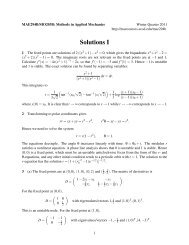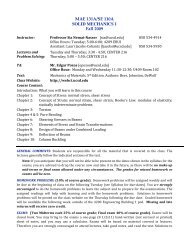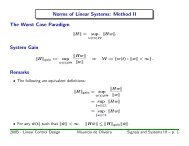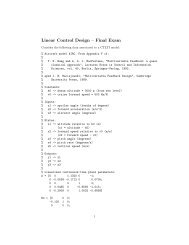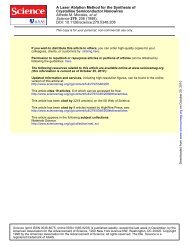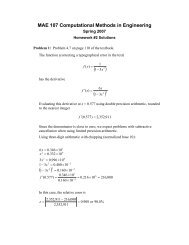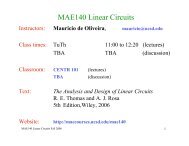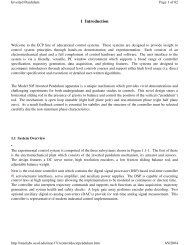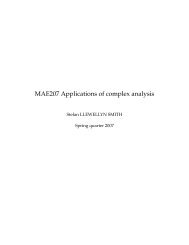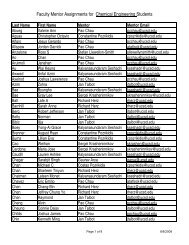solution
solution
solution
Create successful ePaper yourself
Turn your PDF publications into a flip-book with our unique Google optimized e-Paper software.
Problem 1 (Chapter 8, P. 22)<br />
T 0 = 2 , 0<br />
1<br />
f = , ω0 = π ,<br />
2<br />
Homework 5<br />
⎧ ⎪sin(2<br />
πt),<br />
t < 1/ 2<br />
xt () = ⎨<br />
, as shown in figures (dotted line).<br />
⎪⎩ 0, 1/ 2 < t < 1<br />
Find the harmonic function X[ k ] by:<br />
1<br />
T0<br />
− jkω0t X[ k] = x( t) e dt<br />
T ∫0<br />
0<br />
1<br />
=<br />
2 ∫<br />
1/2<br />
−1/2<br />
1<br />
=<br />
2 ∫<br />
1<br />
−1<br />
− jkπt x() te dt<br />
− jkπt 1<br />
sin(2 πte<br />
) dt=<br />
∫<br />
e − e<br />
j<br />
j2πt − j2πt 1/2<br />
− jkπ t<br />
e dt<br />
2 −1/2<br />
2<br />
(2 )<br />
1/2<br />
(2 )<br />
1/2<br />
1 1/2<br />
j(2 −k) πt − j(2 + k) πt<br />
1 ⎡ j −k πt − j + k πt<br />
e e ⎤<br />
= ( e −e<br />
) dt<br />
4 j ∫<br />
= ⎢ +<br />
⎥<br />
−1/2<br />
4 j ⎢ jπ(2 − k) jπ(2 + k)<br />
⎣ −1/2 −1/2⎥⎦<br />
⎡ π π ⎤<br />
sin( (2 )) sin( (2 ))<br />
1 ⎢<br />
− k + k<br />
2 2 ⎥<br />
= ⎢ −<br />
⎥<br />
2 j<br />
⎢ π(2 − k) π(2<br />
+ k)<br />
⎥<br />
⎣ ⎦<br />
j ⎡ 2− k 2+<br />
k ⎤<br />
=− sin c( )-sinc( )<br />
4⎢ ⎣ 2 2 ⎥<br />
⎦<br />
So, the complex CTFS description is:<br />
Approximation to the signal:<br />
Code:<br />
k =∞<br />
jk t<br />
x() t X[ k] e π<br />
= ∑<br />
k= N<br />
k =−∞<br />
jk t<br />
xN () t X[ k] e π<br />
= ∑ , as shown is figures (solid line)<br />
k=−N clear all<br />
T0 = 2;<br />
icount = 0;<br />
for t = -3:0.01:3; % To get x(t)<br />
icount = icount+1;<br />
if abs(t-round(t/T0)*T0)
else x_t(icount) = 0;<br />
end<br />
end<br />
tt = -3:0.01:3;<br />
figure(1);subplot(2,1,1),plot(tt,x_t,':');hold on<br />
x_Nt = zeros(size(t)); % To get x[k]<br />
N = 1; % N=1,2,3<br />
for k = 1:N;<br />
X_k1(k) = -j/4*(sinc((2-k)/2)-sinc((2+k)/2));<br />
X_k2(k) = -j/4*(sinc((2+k)/2)-sinc((2-k)/2));<br />
x_Nt = x_Nt+X_k1(k)*exp(j*2*pi*k*1/T0*tt)++X_k2(k)*exp(-j*2*pi*k*1/T0*tt);<br />
end<br />
figure(1);subplot(2,1,1),plot(tt,x_Nt);hold off<br />
N=1<br />
1<br />
x(t)<br />
x(t)<br />
x(t)<br />
0.5<br />
0<br />
-0.5<br />
-1<br />
-3 -2 -1 0 1 2 3<br />
1<br />
0.5<br />
0<br />
-0.5<br />
-1<br />
-3 -2 -1 0 1 2 3<br />
1<br />
0.5<br />
0<br />
-0.5<br />
t<br />
N=2<br />
-1<br />
-3 -2 -1 0 1 2 3<br />
t<br />
N=3<br />
t
Problem 2 (Chapter 8, P. 23)<br />
From (a) to (d), we got<br />
x () t = x () t + 2cos(2 Nπt) N N−1<br />
= x ( t) + 2cos(2( N − 1) πt) + 2cos(2 Nπt) <br />
N −2<br />
= x ( t) + 2cos(2 πt) + 2cos(4 πt) + + 2cos(2 Nπt) <br />
0<br />
N<br />
= 1+∑ 2 cos(2 nπt) = ∑ e<br />
n=<br />
1<br />
N<br />
n=−N j2nπt Signals for N = 0,1,2,20 are shown as follow over the time range − 3< t < 3.<br />
By<br />
numerically calculate the area of the signal over − 1/2 < t < 1/2,<br />
we got:<br />
( a) N = 0, area=<br />
1,<br />
( b) N = 1, area=<br />
1,<br />
() c N = 2, area=<br />
1,<br />
( d) N = 20, area=<br />
1<br />
As N become lager, for case N = ∞ ,<br />
j2nπt x () t = ∑ e tends to a function x() t<br />
N<br />
∞<br />
n=−∞<br />
with 0 1 T = and Xk [ ] = 1.<br />
From the table we can find that, x() t is a unit period<br />
impulse ( xt ( ) = δ ( t) ↔ Xk [ ] = 1).<br />
Clearly see in plots, as N increases the figure<br />
become more like the impulse train and the area within one period should be 1.<br />
Code:<br />
t = -3:0.01:3; x_Nt = zeros(size(t))+1; N0 = 20; % N0=0,1,2,20 for part a,b,c,d<br />
for n = 1:N0;<br />
x_Nt = x_Nt+2*cos(2*n*pi*t);<br />
end<br />
figure(2),subplot(2,1,1),plot(t,x_Nt);<br />
num1 = find(t==-1/2);num2 = find(t==1/2);<br />
Area = sum((x_Nt(num1:num2-1))*0.01, % Summation should end at num2-1<br />
N=0<br />
2<br />
x 0 (t)<br />
1.5<br />
1<br />
0.5<br />
0<br />
-3 -2 -1 0 1 2 3<br />
t
x 1 (t)<br />
x 2 (t)<br />
x 20 (t)<br />
3<br />
2<br />
1<br />
0<br />
N=1<br />
-1<br />
-3 -2 -1 0 1 2 3<br />
6<br />
4<br />
2<br />
0<br />
-2<br />
-3 -2 -1 0 1 2 3<br />
60<br />
40<br />
20<br />
0<br />
t<br />
N=2<br />
-20<br />
-3 -2 -1 0 1 2 3<br />
Problem 3 (Chapter 8, P. 30)<br />
t<br />
N=20<br />
(1) From the first figure in Figure E.30, the signal is even with T0 = 2, ω0 = π<br />
So,<br />
1<br />
T0<br />
− jkω0t X[ k] = x( t) e dt<br />
T ∫0<br />
0<br />
1<br />
=<br />
2 ∫<br />
1<br />
−1<br />
t<br />
− jkπt x() te dt<br />
1 1<br />
= x( t)[cos( kπt) jsin( kπt)] dt<br />
2 ∫ − + −<br />
−1<br />
1 1 j 1<br />
= ()cos( ) ()sin( )<br />
2∫ x t kπt dt− x t kπt dt<br />
−1 2∫−1<br />
even odd<br />
j 1<br />
()sin( ) 0<br />
2 ∫ x t kπt dt = , the harmonic function X[ k ] have a purely real value<br />
−1
for every value of k .<br />
(2) From the second figure in Figure E.30, the signal is odd with T0 = 1, ω0 = 2π<br />
1<br />
T0<br />
− jkω0t X[ k] = x( t) e dt<br />
T ∫0<br />
0<br />
1/2<br />
= ∫<br />
1/2<br />
2<br />
1/2 ()<br />
− jk πt<br />
x te dt<br />
−<br />
1/2 1/2<br />
∫ ∫<br />
= x( t)cos(2 kπt) dt− j x( t)sin(2 kπt) dt<br />
−1/2 −1/2<br />
<br />
odd<br />
even<br />
So, x()cos(2 t k t) dt 0<br />
1/2 π ∫ = , the harmonic function X[ k ] have a purely imaginary<br />
−<br />
value for every value of k .<br />
Problem 4 (Chapter 8, P. 32)<br />
Period of a sine wave is<br />
1<br />
6<br />
10 ; period of a burst of “1” is 1<br />
; period of a burst of “0”<br />
5<br />
10<br />
1<br />
is 5<br />
10 ; period of a binary signal with alternating 1’s and 0’s is 1<br />
T 0 = 2× and 5<br />
10<br />
ω π<br />
5<br />
0 = × 10 . The binary signal we want should be like:<br />
x(t)<br />
1<br />
0.5<br />
0<br />
-0.5<br />
-3 -2 -1 0 1 2 3<br />
x 10 -5<br />
-1<br />
t<br />
How can it come?<br />
As we already know the basic sine wave is<br />
x 1 (t)<br />
1<br />
0.5<br />
0<br />
-0.5<br />
x t = × t , shown as<br />
6<br />
1 () sin(210 ) π<br />
-3 -2 -1 0 1 2 3<br />
x 10 -5<br />
-1<br />
t<br />
In order to get the wanted signal, the signal shown above should multiply with a
square wave signal 2 () x t looks like:<br />
x 2 (t)<br />
1<br />
0.5<br />
0<br />
-0.5<br />
-3 -2 -1 0 1 2 3<br />
x 10 -5<br />
-1<br />
t<br />
How to get this square wave signal? It’s just from a similar and basic function 3 () x t ,<br />
as shown below. Then x2() t = x3() t × 2− 1.<br />
x 3 (t)<br />
1<br />
0.5<br />
-3 -2 -1 0 1 2 3<br />
x 10 -5<br />
0<br />
t<br />
The expression for this x3 () t is just a convolution of a rectangle function and<br />
impulse train:<br />
⎛ t ⎞<br />
x3() t = rect ⎜ δ 5 5 () t 21/10 × 1/10<br />
⎟∗<br />
⎝ ⎠<br />
⎛ t ⎞<br />
x () 2 x () t − 1= 2rect ∗ () t − 1<br />
⎝1/10 ⎠<br />
⇒ 2 t = 3 ⎜ δ 5 ⎟<br />
5 21/10 ×<br />
6 ⎛ ⎛ t ⎞<br />
⎞<br />
xt () = x1() t x2() t = sin(2× 10 πt) ×⎜2rect ⎜ 5 δ 5 () t 1<br />
21/10 × ⎟<br />
1/10<br />
⎟∗<br />
−<br />
⎝ ⎝ ⎠<br />
⎠<br />
1<br />
From Fourier Series Pairs table, with T 0 = 2× 5<br />
10<br />
,<br />
1<br />
rectangular function is T = 5<br />
10<br />
,<br />
ω π<br />
5<br />
0 = × 10 , width of
5 5 5<br />
⎡ ⎛ × kπ<br />
× ⎞ ⎤<br />
⎢ 5 ⎜ ⎟ ⎥<br />
1 1/10 1/10 10<br />
X[ k] = ⎡δ[ k 20 ] δ[ k 20] 2 sinc<br />
δ[<br />
k]<br />
2j ⎣ − − + ⎤⎦∗<br />
× −<br />
⎣ 2/10 ⎝ 2 ⎠ ⎦<br />
1<br />
⎡ ⎛kπ⎞ ⎤<br />
= ⎡δ[ k 20 ] δ[ k 20] ⎤ sinc δ[<br />
k]<br />
2j ⎣ − − + ⎦∗⎢⎜<br />
⎟−<br />
2<br />
⎥<br />
⎣ ⎝ ⎠ ⎦<br />
j ⎡ ⎛( k− 20) π ⎞ ⎛( k+<br />
20) π ⎞<br />
⎤<br />
=− sinc sinc δ[ k 20 ] δ[<br />
k 20]<br />
2<br />
⎢ ⎜ ⎟−⎜ ⎟−−<br />
+ +<br />
2 2<br />
⎥<br />
⎣ ⎝ ⎠ ⎝ ⎠<br />
⎦<br />
The magnitude and phase of the harmonic function are shown as follow:<br />
|X[k]|<br />
Phase of X[k]<br />
Code:<br />
0.1<br />
0.05<br />
0<br />
-30 -20 -10 0 10 20 30<br />
2<br />
1<br />
0<br />
-1<br />
-2<br />
-30 -20 -10 0 10 20 30<br />
k = -30:30;<br />
N_k = 1/(2*j).*(sinc(pi/2.*(k-20))-sinc(pi/2.*(k+20))-dirac(k-20)+dirac(k+20));<br />
figure(1), subplot(2,1,1),stem(k,abs(N_k),'fill'),<br />
figure(1), subplot(2,1,2),stem(k,angle(N_k),'fill'),<br />
Problem 5 (Chapter 12, P. 32)<br />
10 jω10 jω<br />
jω+ 10 jω+ 10 ( jω) + 20 jω+<br />
100<br />
(b). H( jω)<br />
= ⋅ = 2<br />
Code:<br />
k<br />
k
omg = 0.1:0.1:1000;<br />
num = [10,0];den = [1,20,100];<br />
sys = tf(num,den);<br />
figure(1),bode(omg,sys);grid on; % using "bode" to get the Bode diagram<br />
Magnitude (dB)<br />
Phase (deg)<br />
0<br />
-20<br />
-40<br />
-60<br />
90<br />
45<br />
0<br />
-45<br />
-90<br />
10 -1<br />
Asymptote:<br />
10 0<br />
j10ω<br />
H( jω)<br />
=<br />
( jω<br />
+ 10)<br />
2<br />
10 1<br />
10 2<br />
10 jω<br />
= ⋅<br />
jω+ 10 jω+<br />
10<br />
From the expression, we see the frequency response have: zero at jω = 0 , pole at<br />
jω =− 10 and pole at jω =− 10 .<br />
(1). Magnitude asymptote<br />
First consider the part<br />
10<br />
jω + 10<br />
10<br />
20log10 0<br />
10 = . For high frequencies ( ω ω p<br />
10 3<br />
. For low frequencies ( ω ω p ), the dB-scale magnitude is<br />
20log<br />
), magnitude should be 10<br />
10<br />
, which<br />
jω<br />
is a straight line with the slope of -20dB and go through (10,0). The magnitude<br />
asymptote from<br />
10<br />
jω + 10<br />
is a pair of straight lines with corner frequency at ω p = 10 ,
as shown (dashed line).<br />
Similarly, for part<br />
jω<br />
jω<br />
+ 10<br />
jω jω<br />
20log ≈ 20log<br />
jω<br />
+ 10 10<br />
, 10 10<br />
at low frequencies<br />
( ω ω p ), which is a straight line with the slope of 20dB and go through (10,0). At high<br />
frequencies ( ω ω p<br />
asymptote from<br />
(dotted line).<br />
jω jω<br />
20log ≈ 20log = 0 . So, the magnitude<br />
jω+ 10 jω<br />
), 10 10<br />
jω<br />
jω<br />
+ 10<br />
is also a pair of straight lines intersect at ω = ω p , as shown<br />
At last, applying compose the dashed line and dotted line to get the final magnitude<br />
asymptote, as shown (solid line).<br />
gain factor<br />
gain factor<br />
0<br />
-10<br />
-20<br />
-30<br />
-40<br />
10 -1<br />
0<br />
-10<br />
-20<br />
-30<br />
-40<br />
10 -1<br />
(2). Phase asymptote<br />
The phase asymptote from<br />
( ω ω 10 ) and<br />
p<br />
10 0<br />
10 0<br />
10<br />
jω + 10<br />
10 1<br />
ω<br />
10 1<br />
ω<br />
10 2<br />
10 2<br />
10 3<br />
10 3<br />
contains three segments: 0 for low frequencies<br />
π<br />
− for high frequencies ( ω 10ω p ), and at frequencies around<br />
2
π<br />
ω p = 10 , a straight line (reference to log10 ω ) achieves the − phase change, as<br />
2<br />
shown (dashed line).<br />
jω<br />
π<br />
Similarly, for part , for low frequencies ( ω ω p 10 ) and 0 for high<br />
jω<br />
+ 10 2<br />
π<br />
frequencies ( ω 10ω p ), a straight line at ω p /10 < ω < 10ωp<br />
gives the − phase<br />
2<br />
change, as shown (dotted line).<br />
At last, applying composition rules to get the final phase asymptote, as shown (solid<br />
line).<br />
phase factor<br />
phase factor<br />
Code:<br />
2<br />
1<br />
0<br />
-1<br />
-2<br />
10 -1<br />
2<br />
1<br />
0<br />
-1<br />
-2<br />
10 -1<br />
10 0<br />
10 0<br />
omg = 0.1:0.1:1000;<br />
omg_p = 10;<br />
omg1 = 0.1:0.1:omg_p;<br />
omg2 = omg_p+0.1:0.1:1000;<br />
ym = zeros(size(omg));<br />
ym_1 = ones(size(omg1)); % get the magnitude asymptote for low frequency<br />
ym_2 = omg_p./omg2; % get the magnitude asymptote for high frequency<br />
ym(1:length(omg1)) = ym_1;<br />
ym(length(omg1)+1:end)= ym_2;<br />
10 1<br />
ω<br />
10 1<br />
ω<br />
10 2<br />
10 2<br />
10 3<br />
10 3
asym_1 = 20*log10(ym);<br />
figure(2),subplot(2,1,1),semilogx(omg,asym_1,'--'),hold on<br />
xlabel('\omega'),ylabel('gain factor')<br />
zm = zeros(size(omg));<br />
zm_1 = omg1/omg_p; % get the magnitude asymptote from the pole for low frequency<br />
zm_2 = ones(size(omg2)); % get the magnitude asymptote from the pole for high frequency<br />
zm(1:length(omg1)) = zm_1;<br />
zm(length(omg1)+1:end) = zm_2;<br />
asym_2 = 20*log10(zm);<br />
figure(2),subplot(2,1,1),semilogx(omg,asym_2,':'),hold off<br />
omg3 = 0.1:0.1:omg_p/10;<br />
omg4 = omg_p/10+0.1:0.1:omg_p*10;<br />
omg5 = omg_p*10+0.1:0.1:1000;<br />
yp = zeros(size(omg));<br />
yp_1 = zeros(size(omg3)); % phase is zero for low frequency<br />
yp_2 = -1*pi/2/2*(log10(omg4)-log10(omg_p/10));<br />
% a -pi/2 phase change from omg_p/10 to omg_p*10<br />
yp_3 = -1*pi/2*ones(size(omg5)); % phase is -pi/2 for high frequency<br />
yp(1:length(omg3)) = yp_1;<br />
yp(length(omg3)+1:length(omg3)+length(omg4))= yp_2;<br />
yp(length(omg3)+length(omg4)+1:end)= yp_3;<br />
asym_1_ph = yp;<br />
figure(3),subplot(2,1,1),semilogx(omg,asym_1_ph,'--'),hold on<br />
xlabel('\omega'),ylabel('phase factor')<br />
zp = zeros(size(omg));<br />
zp_1 = pi/2*ones(size(omg3)); % phase is pi/2 for low frequency<br />
zp_2 = -1*pi/2/2*(log10(omg4)-log10(omg_p*10));<br />
% a -pi/2 phase change from omg_p/10 to omg_p*10<br />
zp_3 = zeros(size(omg5)); % phase is 0 for high frequency<br />
zp(1:length(omg3)) = zp_1;<br />
zp(length(omg3)+1:length(omg3)+length(omg4))= zp_2;<br />
zp(length(omg3)+length(omg4)+1:end)= zp_3;<br />
asym_2_ph = zp;<br />
figure(3),subplot(2,1,1),semilogx(omg,asym_2_ph,':'),hold off<br />
asym_m = asym_1+asym_2; % composition for magnitide<br />
figure(2),subplot(2,1,2),semilogx(omg,asym_m),<br />
xlabel('\omega'),ylabel('gain factor')<br />
asym_ph = asym_1_ph+asym_2_ph; % composition for phase<br />
figure(3),subplot(2,1,2),semilogx(omg,asym_ph),<br />
xlabel('\omega'),ylabel('phase factor')<br />
j20ω 20 jω<br />
( )<br />
10000 − ω + j20 ω ( jω) + 20 jω+<br />
10000<br />
(c). H jω=<br />
=<br />
2 2
Code:<br />
omg = 0.01:0.01:10000;<br />
num = [20,0];den = [1,20,10000];<br />
sys = tf(num,den);<br />
figure(1),bode(omg,sys);grid on<br />
Magnitude (dB)<br />
Phase (deg)<br />
0<br />
-10<br />
-20<br />
-30<br />
-40<br />
90<br />
45<br />
0<br />
-45<br />
-90<br />
10 1<br />
Asymptote:<br />
Bode Diagram<br />
10 2<br />
Frequency (rad/sec)<br />
j20ω<br />
H( jω)<br />
=<br />
( jω+ 10 − j99.5)( jω+ 10 + j99.5)<br />
ω<br />
j<br />
j20ω<br />
=<br />
= 500<br />
2<br />
2<br />
⎡ ω ω ⎤<br />
10000 ⎢1− + j<br />
⎛ ω ⎞ ω<br />
10000 500<br />
⎥ 1−<br />
⎜ ⎟ + j<br />
⎣ ⎦ ⎝100 ⎠ 500<br />
From the expression, we see the frequency response have: zero at jω = 0 , a pair of<br />
complex conjugate poles at jω =− 10 + j99.5<br />
and jω = −10 − j99.5<br />
.<br />
(1). Magnitude asymptote<br />
10 3
The dB-scale magnitude asymptote from zero j<br />
500<br />
ω is a straight line with a slope of<br />
20dB and go through (500,0), as shown (dashed line).<br />
The dB-scale magnitude asymptote from pole<br />
⎛ ω ⎞ ω<br />
1−<br />
⎜ ⎟ + j<br />
⎝100 ⎠ 500<br />
2<br />
is a pair of straight<br />
lines and ω p = 100 . For low frequency ( ω ω p ), it’s a straight line with a slope of<br />
0dB. For high frequency ( ω ω p ), it’s a straight line with a slope of -40dB. These<br />
two asymptotes intersect at ω = ω p , as shown (dotted line).<br />
Then, applying composition rules to get the final magnitude asymptote: dashed line<br />
plus dotted line, as shown (solid line).<br />
gain factor<br />
gain factor<br />
50<br />
0<br />
-50<br />
-100<br />
-10<br />
-20<br />
-30<br />
-40<br />
-50<br />
-60<br />
10 0<br />
10 0<br />
(2). Phase asymptote<br />
10 1<br />
10 1<br />
10 2<br />
ω<br />
10 2<br />
The phase asymptote from zero j<br />
500<br />
ω is a straight line with a slope of 0 at phase<br />
π<br />
equals , as shown (dashed line).<br />
2<br />
The phase asymptote from pole<br />
ω<br />
⎛ ω ⎞ ω<br />
1−<br />
⎜ ⎟ + j<br />
⎝100 ⎠ 500<br />
2<br />
10 3<br />
10 3<br />
10 4<br />
10 4<br />
contains three segments and
ω = 100 . For low frequency ( ω ω 10 ), it’s a straight line with a slope of 0 at<br />
p<br />
p<br />
phase equals 0. For high frequency ( ω 10ω p ), it’s a straight line with a slope of 0 at<br />
phase equals − π . Then for frequencies between them ( ω 10 < ω < 10ω<br />
), the<br />
p p<br />
straight line (reference to log10 ω ) achieves the − π phase change, as shown (dotted<br />
line). Then, get the phase asymptote by applying composition rules: dashed line plus<br />
dotted line, as shown (solid line).<br />
phase factor<br />
phase factor<br />
Code:<br />
2<br />
0<br />
-2<br />
-4<br />
10 0<br />
2<br />
1<br />
0<br />
-1<br />
-2<br />
10 0<br />
10 1<br />
10 1<br />
clear all<br />
omg = 1:1:10000;<br />
asym_z = 20*log10(omg/500); % get the magnitude asymptote from zero<br />
figure(2),subplot(2,1,1),semilogx(omg,asym_z,'--'),hold on<br />
xlabel('\omega'),ylabel('gain factor')<br />
asym_z_ph = pi/2*ones(size(omg)); % get the phase asymptote from zero<br />
figure(3),subplot(2,1,1),semilogx(omg,asym_z_ph,'--'),hold on<br />
xlabel('\omega'),ylabel('phase factor')<br />
omg_p = 100;<br />
omg1 = 1:1:omg_p;<br />
10 2<br />
ω<br />
10 2<br />
ω<br />
10 3<br />
10 3<br />
10 4<br />
10 4
omg2 = omg_p+1:1:10000;<br />
ym = zeros(size(omg)); % get the magnitude asymptote from the pole for low frequency<br />
ym_1 = ones(size(omg1)); % get the magnitude asymptote from the pole for high frequency<br />
ym_2 = omg2/omg_p;<br />
ym(1:length(omg1)) = ym_1;<br />
ym(length(omg1)+1:end)= ym_2;<br />
asym_p = -40*log10(ym);<br />
figure(2),subplot(2,1,1),semilogx(omg,asym_p,':'),hold off<br />
omg3 = 1:1:omg_p/10;<br />
omg4 = omg_p/10+1:1:omg_p*10;<br />
omg5 = omg_p*10+1:1:10000;<br />
yp = zeros(size(omg));<br />
yp_1 = zeros(size(omg3));<br />
yp_2 = -1*pi/2*(log10(omg4)-log10(omg_p/10));<br />
% a -pi/2 phase change from omg_p/10 to omg_p*10<br />
yp_3 = -1*pi*ones(size(omg5));<br />
yp(1:length(omg3)) = yp_1;<br />
yp(length(omg3)+1:length(omg3)+length(omg4))= yp_2;<br />
yp(length(omg3)+length(omg4)+1:end)= yp_3;<br />
asym_p_ph = yp;<br />
figure(3),subplot(2,1,1),semilogx(omg,asym_p_ph,':'),hold off<br />
asym_m = asym_z+asym_p; % composition for magnitude asymptote<br />
figure(2),subplot(2,1,2),semilogx(omg,asym_m),<br />
xlabel('\omega'),ylabel('gain factor')<br />
asym_ph = asym_z_ph+asym_p_ph;<br />
figure(3),subplot(2,1,2),semilogx(omg,asym_ph), % composition for phase asymptote<br />
xlabel('\omega'),ylabel('phase factor')



